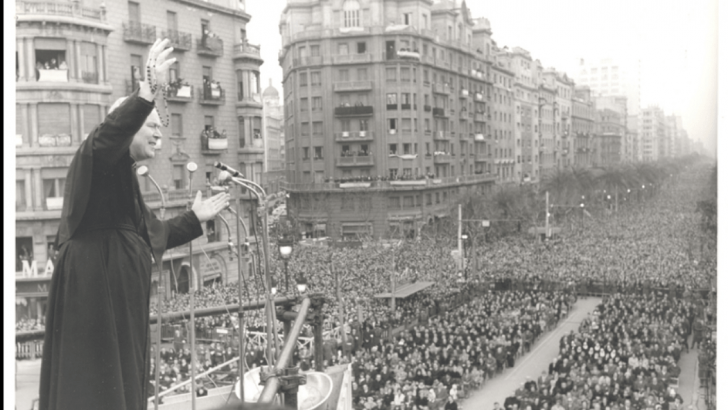The Rosary Priest: A Biography of Patrick Peyton CSC
by Tom Mulligan (Veritas, €15.00)
I had the privilege of meeting Fr Patrick Peyton, CSC. A handsome man, standing at six feet four inches, he was a refreshingly simple person. And yet there was an aura about him. It was the same aura one sensed in the presence of Frank Duff, co-founder of the Legion of Mary.
That aura stemmed from the total commitment each of them had to what they regarded as their life’s mission. In the case of Mr Duff it was his promotion of devotion to Mary, in the case of Fr Peyton it was the popularising of prayer and the family rosary.
Fr Peyton was born in Carracastle, near Ballina, Co Mayo, on June 9, 1909. He had six sisters and three brothers. Aged 15, he left school to work on the 15-acre family farm. He was also employed by Mayo County Council repairing the local roads.
At the age of 18 Patrick and his brother Tom joined three of their sisters in Scranton, Pennsylvania. While Tom found employment in a coalmine, Patrick, following a spell working on a building site, became the caretaker in St Peter’s Cathedral in Scranton.
When he confided to Msgr Paul Kelly, administrator of the cathedral, that he believed he had a vocation to the priesthood. Msgr Kelly had him and his brother Tom attend a local Christian Brothers School and thereafter enrolled them in the major seminary of the Congregation of the Holy Cross at Notre Dame in Indiana.
Health
Patrick was just a few years into his studies when he suddenly became gravely ill with “advanced tuberculosis”. Just as suddenly and with no scientific explanation he regained his health. Ever afterwards he was convinced that his recovery was due to the intercession of Mary.
Patrick and Tom were ordained at Notre Dame in June 1941. Tom was assigned to parish ministry in New Orleans. Patrick resolved that he would devote his life to promoting the daily recitation of the Rosary in family homes just as his own family had recited it in their home at Carracastle.
He was appointed chaplain to a high-school conducted by the Sisters of Mercy in Albany, New York State, where the Sisters and some of their students helped him to set-up his Family Rosary Crusade in 1943.
With many families in North America having their men-folk in harm’s way in various theatres of war it was an opportune time to promote prayer and Patrick received the enthusiastic support of many bishops in Canada and the US.
Patrick took his crusade to the air-waves in the mid-1940s. At that time also he had an opportunity to present it in the Church of the Good Shepherd in Beverly Hills, where many of Hollywood’s stars worshipped. They were impressed by his simplicity and sincerity and subsequently some of Hollywood’s best-known actors and actresses participated in his Rosary crusade’s radio programmes and later TV presentations.
The list of those who were particularly helpful to him included Ethel Barrymore, Ann Blyth, Irene Dunne, Maureen O’Hara, Maureen O’Sullivan, Shirley Temple, Jane Wyatt, Loretta Young, Don Ameche, Charles Boyer, Bing Crosby, Bob Hope, Gregory Peck, Ronald Reagan and James Stewart.
For more than 40 years Patrick and his co-workers organised enormous rallies to promote his Rosary crusade. These he held in countries across the world and on all five continents. The size of most of these rallies dwarfed even the large gatherings presided over by Rev. Billy Graham, the legendary Bible evangelist.
***
After World War II came the Cold War, during which there was a titanic struggle for hearts and minds. It was a time when Western democracies were in danger of being overwhelmed by Stalin’s Soviet Union and Mao Zedong’s Peoples Republic of China.
While Patrick never regarded his rallies to be other than to promote prayer and the family Rosary, they were an implicit counterpoint to the atheistic communist propaganda of the Cold War period. Their influence in that regard was particularly significant in Latin America and Asia.
In 1963 the Rosary crusade in Brazil was wound up with a rally in Rio de Janeiro, which attracted more than 1.5 million people. Soon afterwards the government, which had lurched to the far left, was swept out of office.
In 1985 the Rosary crusade in the Philippines ended with a rally in Manila which attracted more than two million people. Within a few months Ferdinand Marcos, who had ruled as a dictator since 1965, was ousted in a bloodless coup.
(One is reminded of Pope John Paul II’s address at Warsaw in 1983 – one of the seminal speeches of the 20th Century which heralded the collapse of communism in Eastern Europe and the end of the Soviet Empire.)
Patrick, it seems, experienced immense satisfaction as he organised the Rosary crusade in the dioceses of Ireland.
When it was concluded the Irish bishops appointed Fr Gabriel Harty, a Dublin diocesan priest who became a Dominican, to be national director of the Rosary crusade.
Patrick received many awards and honours but the one he cherished most was one he received from Mayo County Council on the occasion of the golden jubilee of his priesthood. He died on June 3, 1992. The process for his canonisation began in 1993. He was named Venerable in 2012.
This is a splendid biography of a distinguished Mayo man, of whom all Irish people can be justly proud.


 Fr Peyton addressing a rally
Fr Peyton addressing a rally